|
[Front Page] [Features] [Departments] [SGAP Home Page] [Subscribe]

Electronic Mailbox
 
The following have been selected from the questions received on the SGAP World Wide web site over the past few months and from contributions directed to the Electronic Mailbox specifically. You're welcome to comment on any issue concerning Australian native plants....growing, propagating or appreciating...anything.
Even bung a message in a bottle if your net connection goes down!!

Too much of a good thing?
I am quite interested in Australian Flora, and would like to know why Australian native plants have a low tolerance to phosphate.
I would very much appreciate your insights.
Stan Grayson,
USA
Funny you should ask! By coincidence, there is an article on that very topic in this issue (see "Phosphorus Needs of Australian Plants" for the full picture).
Like most things it's not quite as simple as it might seem.
Firstly, it's not correct to say that Australian plants generally have a low phosphate tolerance, The majority don't have any more phosphorus intolerance than plants from other parts of the world. It is true, however, that there are a significant number which are phosphorus sensitive and it just happens that some of these are the ones commonly cultivated.
I'm no expert on this but, as I understand it, many of the cultivated Australian plants are native to nutrient deficient soils and particularly P deficient soils. This is possibly due to the geological structures being old and weathered leading to the leaching out of nutrients.
Many of the plants native to these soils have developed efficient ways to extract their nutrient needs. In particular, the members of the Protea family (Banksia, Grevillea, Hakea, etc) have developed masses of very fine rootlets (called "proteoid" roots) which have a high surface area and are believed to be designed to take up nutrients from the poor soils.
 
The problem is that when these plants are cultivated and fertilised, these roots can take up nutrients, particularly phosphorus, in toxic amounts.
Select the thumbnail image for a higher resolution image. (39k)
The situation with non-proteaceous plants is less clear. Perhaps they have just adapted to low levels of P and can't tolerate what might be normal amounts to other plants.

Plant Breeder's Rights - A Response
I read with interest your comments in "First Cuttings" on protecting Australian native plants (June 1997 issue).
I agree that there are some 'grey areas' especially when dealing with native species. However, there are some important points which need to be clarified. Firstly, for a new form of a native species to be eligible under Plant Breeder's Rights (PBR), it must have been discovered and selectively propagated so as to develop a new variety. Discovery alone is not sufficient. The main difficulty is in determining whether the 'new variety' is distinct from the existing native population. The PBR office seeks advice from the Australian Cultivar Registration Authority for all applications involving native species. If the features of the 'new variety' allow it to be considered distinct from the known or published characteristics of the species, then it can be accepted into the scheme. Applications for varieties in which a naturalised form has been stabilised have been accepted previously, however, current policy is to 'tighten up' on such applications. Applications for native species are handled on a 'case by case' basis and assessed on their individual merits.
Secondly there are a number of misconceptions about the extent of an owners rights under PBR. Rights cannot be obtained for a 'form' which is already in commerce. In addition PBR is specific to the described variety and does not cover the species.
The issue of someone discovering the same or similar plant as a PBR'd variety applies to all plants not just native species. For example the same apple 'sport' could occur independently in different orchards. If PBR has been previously obtained then the second 'sport' cannot be commercialised.
Please contact me if you wish to further discuss the above issues.
Nik Hulse,
A/g Senior Examiner,
Plant Breeders Rights Office,
Canberra, Australia
Thanks, Nik. I think that you have clarified the position to a large extent, particularly in regard to distinguishing a new variety from a naturally occurring population.
I'm not sure that I fully agree that the discovery of a native plant form which is similar to a PBR'd variety is analogous to the apple "sport" example. In the case of the native plant, it would have existed well before the PBR allocation but had just not been discovered. Assuming that the form was collected legally, why should it be then illegal to propagate and sell it, irrespective of the PBR? This is probably an unlikely scenario, but it's not an impossible one.

Spanish Exchange!
I am a keen Spanish grower of Australian trees and shrubs. I am Interested in contacting others with a similar interest to exchange seeds and experiences. I reside in a region with a humid and temperate climate.
Julio Taboada,
roqueoliva@redestb.es
We have a number of growers of Australian plants in Europe. Perhaps this is an opportunity for them to arrange some informal contact. If you're interested, please contact Julio.

When to collect seed; can you help?......
My current interest in Australian native plants is the growing of plants from seed and the planting out of these plant back into the local area.
My main problem is knowing when to collect seed from the various species. I would like to suggest that a section be added to the quarterly newsletter, listing which species will be ready for seed collection over the
next few months or perhaps a once-off article covering a full year of seed collection.
My local area is in Werribee, Victoria, and I do most of my seed collection from the area around the river as this is where most of my plants are returned to. Even without the listing I will continue as I am at the moment, walking the river and the local parks finding out what's in flower and when the seeds are available, raising them and finding out what works and what doesn't.
I don't expect this to be a small task. It may be possible to have the readers of the magazine do the research. I am happy to send in any information I have.
Scott Thomson,
Werribee, Victoria
To paraphrase a famous line from a moderately successful movie...."If you tell me, I will publish!"
This sort of information is surprisingly difficult to come across. Many books list flowering times but most don't mention the period of time after flowering that seed will be ripe. However, there is a short list of fruiting times for rainforest species at the Greening Australia site, reviewed in Net Watch.
Scott's suggestion is a good one....there must be many people collecting seed from native species and it shouldn't take a lot of time to record the dates and send the information in. So how about it???? If I can get some feedback, I'll list the information on the web site.

Alpine bottlebrush
I recently joined the SGAP Canberra Region and I continue to look for those tough OZ plants with potential to grow in my moderately cold winter area of the US. Canberra Region was a good choice as it has the coldest winter in Australia!
I found a mail order source for Callistemon sieberi or the Alpine Bottlebrush. Are there any particular soil requirements that this shrub needs? It is used a lot in Florida but the soils there are generally more alkaline. Here they are neutral to acidic in pH. Also, my soil is clay but drainage is good.
Larry Little,
USA
 
Callistemon sieberi is a confusing species and the one you've got is probably the one now known as C.pityoides, shown here.
Select the thumbnail image for a higher resolution image. (39k)
Apparently research has shown that the plant previously referred to as C.paludosus was attributable to the original description of C.sieberi, thus requiring the reinstatement of the original name. As a result, a new name (C.pityoides) has been applied to the plant previously known as C.sieberi. (Is all of that clear??? ...there will be questions later :-) )
There are a few forms of the alpine bottlebrush and not all occur in the alps. However, to the best of my knowledge it's a hardy plant which shouldn't cause too many problems. I can't imagine that C.sieberi would occur naturally in alkaline soils and I would expect neutral to slightly acid to be ideal. Callistemons, generally, are reliable in clay soils and will tolerate less than perfect drainage. If the soil is heavy and well drained, I would expect the plant to be quite at home.

The long, hot summer
With the summer coming up and the possibility of it being a hot one like last year or even hotter, I would like to suggest that people put dishes or containers of water out for wildlife.
I feed the local magpies here and have a flat dish under my big gum tree with water in it. Last summer a small baby brushtail possum got out of the nesting box up the tree where it was with its mother It came down to drink out of this dish. I could not catch it but used a hose to spray water on the baby all day in the tree. At one stage it had passed out. I was able to revive it by using the hose. This was one of the 40 degree days and next day was the same temperature. My dog found it down near the dish in the late afternoon. The dog did not get it but I was able to catch it and I took it inside and put in a quiet room. That night, because I hand fed the mother, she took the baby back from me even although it had my scent on it.
The baby grew up and I last saw it some months ago.
If people have any fruit that is slightly bad in one area that they do not feel that they can eat, they could cut the bad piece off and put the rest out in a gum tree if they have one. The possums will soon find it.
Barbara Maple,
Australia
Thanks, Barbara. People can help wildlife cope with the suburban environment is they keep a watchful eye open.
A few years ago my brother-in-law found two juvenile Rainbow Lorikeets which had apparently fallen out of a nest. They were almost full grown but were unable to fly. As we had a small aviary at the time, we became the foster parents of these two raucous larrikins for about 6 months and were eventually able to release them back into the bush.
People who don't have the skill or facilities to look after wildlife can get advice from the local national parks authority.

Eucalyptus germination
I need help in getting Eucalyptus to germinate from seed. I have some varieties that I just can't seem to get any germination from.
Any help you can give would be appreciated.
Mike Gillespie,
Australia
Eucalypts, generally, don't require any special treatment for germination. If you're having problems with some varieties, there are a couple of possibilities:
- Infertile seed. When eucalypts release the seed from their seed capsules, there is usually a combination of infertile seed (called chaff) and fertile seed. The fertile seed is usually larger and darker than the chaff. Perhaps the seed that you have for some varieties is mainly chaff, in which case you can only get some more seed and check it for fertile seed before sowing.
- Cold climate species. Some species (usually those from high altitudes) require a period of cold before they will germinate. This is usually done by placing the seed in a refrigerator for a few weeks before sowing. This is called "stratification". The simplest method is to sow the seed normally in a punnet or pot, cover it and place the container in a refrigerator. The period required under stratification varies with the species and can range from 3 weeks (E.perriniana) up to 10 weeks (E.delegatensis).

More on cats
Last year we moved to the beautiful Yarra Valley. We have planted lots of Australian native plants and are trying hard to attract more birds into the garden. We also have a cat. She lives quite happily inside. (Occasionally she watches the birds outside the window.) I don't see what the problem is with keeping cats inside. We live in the Shire of Yarra Ranges.
 
I don't know why other councils don't have the courage to enforce cat curfews! There is no reason why people, cats and native animals can't all live happily together. They do at my house.
Karen Forde,
Melbourne, Australia
Karen's comment is a follow up to the discussion in the "Electronic Mailbox" in the September 1997 issue.
I think other Councils will eventually come around to adopting cat curfews but the wheels of Government turn slowly!

Collecting bottlebrush seed
Please forgive me if I sound a little of a "layman" but the striking of Australian native plants from cuttings and growing their seeds is my hobby (mine too...ed!!). However, I have no idea of correct botanical names etc.
My question is can I collect seeds from "Bottle Brushes"? If so, what part do I collect? I can only guess that it is the "ball" type pieces left on the stem after flowering, is this correct?
If it is the the "ball" pieces how should I encourage them to sprout?
Warren Prentice,
Penrith, New South Wales, Australia
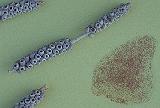 
The "ball type" pieces are the seed capsules which form as cylindrical clusters around the stems. As shown in the accompanying photo, the capsules contain a large number of very small seeds, normally reddish-brown in colour.
Select the thumbnail image for a higher resolution image. (23k)
The idea is to collect the mature capsules, usually 6 months or more after flowering. In most cases the capsules remain on the plant indefinitely, so there will always be mature capsules available.
Put the capsules in an open container for a few days and they will open by themselves to release the seed. These can be sown using the methods outlined on the Society's seed propagation page.
The only thing to be careful of with bottlebrushes is that they often don't come "true" to the parent plant - you'll still get a bottlebrush plant but it might not be as good as the original (or it might be better - it's a bit of a lottery). If you see a good bottlebrush plant it's better to propagate it from cuttings (they strike fairly easily).

Trees for all seasons....
I'm getting together the student 1998 diary for the Central Coast (New South Wales) Campus Union and we'd like to have an Australian tree signifying each month.
Do you have any suggestions as to what tree would be identified with each month? If you could let me know I would be hugely appreciative.
Chris Tola,
Ourimbah, Australia
This sounded like a simple enough request....until I started to think about it in detail!
I decided to take the definition of "tree" fairly liberally and, after a considerable amount of delving though reference books, here's what I came up with. Some of these might be more accurately described as large shrubs. I've also restricted the selection to plants that should grow successfully on the central coast of New South Wales and, naturally, the table is for southern hemisphere growing seasons.
If any readers would like to suggest alternative species, please let me know,
Australian Plants - Month by Month
Select a thumbnail image for a higher resolution image.
| Month | Tree | Feature | Photo |
|---|
| January | Persoonia pinifolia
"Pine-leaved geebung" | Yellow flowers | |
| February | Banksia serrata
"Saw banksia" | Large clusters of typical banksia flowers | 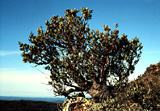 |
| March | Buckinghamia celsissima
"Ivory curl" | Long racemes of cream flowers | |
| April | Backhousia citriodora
"Lemon scented myrtle" | Intense lemon scented foliage; white flower clusters | 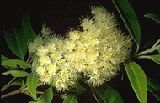 |
| May | Macadamia tetraphylla
"Macadamia" | Edible nuts mature | |
| June | Elaeocarpus reticulatus
"Blueberry ash" | Blue fruits ripen |  |
| July | Eucalyptus sideroxylon
"Red ironbark" - pink form | Conspicuous pink flowers | 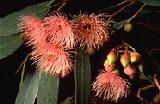 |
| August | Acacia spectabilis
"Mudgee wattle" | Golden flowers | |
| September | Callistemon viminalis
"Weeping bottlebrush" | Masses of red flowers | 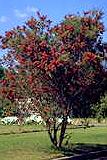 |
| October | Brachychiton acerifolius
"Illawarra flame tree | Spectacular red flowers | |
| November | Grevillea robusta
"Silky oak" | Massed display of orange/yellow flowers | |
| December | Ceratopetalum gummiferum
"NSW Christmas bush" | Pink to red calyxes on the developing fruit | 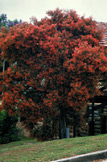 |

Banksias in clay soils
I'm planning a west-facing bed with a number of banksias: Banksia grandis, B.speciosa, B.cunninghamii, and B.spinulosa 'All Gold'. I plan to include the South African plants Protea 'Pink Ice' and Berzelia langinosa as well as the Australian Chamelaucium uncinatum 'Purple Pride', a member of the Myrtaceae.
I've been growing these plants in pots for a year or so, but want finally to get them into the ground. The problem is my soil is heavy
clay, so I'm planning to do more than merely amend. I'm thinking I'll remove the top foot of soil entirely, to be replaced with a sandy loam mixture, and that I'll incorporate some of that mix into the subsoil before I put the new topsoil in place. Does that sound
to you all as if it will work?
I plan to give no phosphorus at all and to water only occasionally and deeply in summer. I'm in Sunset zone 17 (Berkeley, CA), USDA zone 9, I believe.
Any advice will be appreciated.
Wallace Gorell,
California, USA
Sounds fine to me (from this distance)! I've got no experience with B.speciosa and B.grandis as I simply can't grow them in our humid climate on the east coast of Australia. But as long as the drainage is reasonable and the air dry, they should do OK. They come from a very dry summer climate so, once they are established should not require a lot of artificial watering. B cunninghamii and B.spinulosa are both native to eastern Australia (B.spinulosa grows just up the road from where I live!) and grow easily here in light to heavy soils with good drainage. If they have grown successfully in the pots then I'd imagine they will tolerate the conditions you describe. These will appreciate extra water in summer.
The proteas I can't really comment on...the few I've grown have been in deep sandy loam but I don't have the ideal climate for most of them.
The Chamelaucium should also be happy in your sandy loam. Again, as a Western Australian species, eastern Australia is not ideal for them but I've grown a few successfully in deep sandy loam.
As indicated in Kevin Handreck's article on phosphorus toxicity, B.speciosa may not be as sensitive to phosphorus as we have previously believed.
Hope this is of some help

A question of mulch!
What a lovely and informative site.
I need to mulch a fairly large area of garden, although I have the intention of mulching small areas at a time. The garden is made up of Australian Natives (banksias, hakeas, callistemons, grevilleas, lomandras, paper daisies and kangaroo paws), all young (under two years) but established, so it's too late to dig up the whole bed and start over! The soil is poor - a fairly sandy loam but almost water repellent.
What can I use to prevent weed growth and water loss between the established plants. I have considered old carpet felt with a layer of pine bark for aesthetics, but have been unable to get the felt. Would felt be suitable?
Have you any suggestions as to what would make a good thick bed to stop weed growth among the plants, as well as eventually nourish them and help with water? What about shredded or sheets of newspaper? The only mulching I have done before was with new gardens and I had access to heaps of organic mulch, and wonderful soil. I've scanned lots of gardening mags to no real avail and would appreciate your sage advice.
Linda Roy,
Australia
Thanks for the kind words....glad you like the site. But I'm not too sure how "sage" the advice will be!
I can sympathise about the water repellent soil...I have the same problem. Drainage is fantastic here but rain just runs off. I'm hoping for about 4 weeks of constant drizzle to get some water penetration going!
The felt should be OK. Anything that will allow water and air movement into the soil should be suitable. Despite its bad reputation, even something like black plastic can be used provided it is well worked over with a garden fork after it has killed off grass and weeds underneath.
I've used layers of newspaper extensively when constructing new gardens. It works well on a fairly flat area because water can seep through the joins. On a slope the water just tends to run off. The paper needs to be at least 6-8 sheets thick and well overlapped. After a year or two the paper breaks down so weed infestation can reoccur but, by then, the plants should be reasonably well established

Sprouting Kangas
We would like some information as to the germination period of the kangaroo paw.
George Donald,
USA
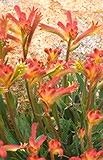 
Well...it depends on the species.
The red and green kangaroo paw (Anigozanthos manglesii) as well as A.flavidus, A.viridis and the cat's paw (A.humilis), shown here, all germinate fairly well without any pretreatment. These normally germinate in 3-4 weeks from an early spring or autumn sowing. Germination of most other kangaroo paws is very unreliable
Select the thumbnail image for a higher resolution image. (42k).

Red silky oak
I live in the USA in the state of Florida. My father had been a Landscape Architect and we had a native Australian tree which he called "Red Silk Oak". There is a similar variety with a gold bloom that is quite common in south and central Florida.
This particular tree, "Red Silk Oak", is much rarer. In fact I've never seen another one like it. It is in the Grevillea genus. It has a different shape to it than its golden-bloomed counterpart. The golden tree has more of a traditional tree...cone shaped. The "Red Silk Oak" had a shape more like a Japanese bonsai plant. This tree had a beautiful red bloom but, unfortunately, it split down the centre of the trunk and died about 20 years ago. Any idea of what kind of tree that was? I'm interested in finding a replacement. It was my father's favourite tree and was the centrepiece for a sunken garden.
Ron Brown,
Florida, USA
The plant is undoubtedly Grevillea banksii. This species has several common names including "Red Silky Oak". It's a common plant in cultivation in Australia and grows well in any warm climate - it's native to sub-tropical areas of Queensland so I would expect that it would grow well in Florida. There are a number of forms and the most common is sometimes known as G.banksii var foresteri. This is a large, silvery-leaved shrub to 3 or 4 metres in height with the red flowers that you describe.
In its natural habitat it can be a tree to 6-10 metres in height. There is also a white flowered form and a couple of prostrate forms. I would have thought that this plant would have been fairly readily available in the USA as it's one of the most commonly grown grevilleas.
In case anyone is wondering, the golden-flowered tree Ron describes is Grevillea robusta, the "Silky Oak".

[Front Page] [Features] [Departments] [SGAP Home Page] [Subscribe]
Australian Plants online - December 1997
The Society for Growing Australian Plants
|